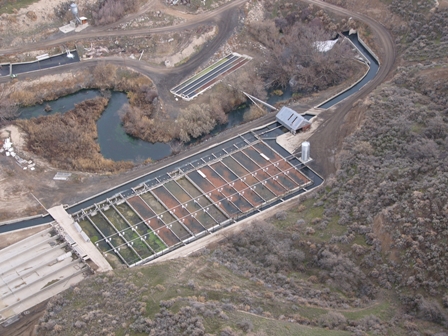For more information please visit your Regional Aquaculture Center
Center for Tropical and Subtropical Aquaculture
North Central Regional Aquaculture Center
Northeastern Regional Aquaculture Center
Southern Regional Aquaculture Center
Western Regional Aquaculture Center
Gary Fornshell, Extension Educator/Aquaculture, University of Idaho
Trout Culture
The trout industry in the United States traces its roots back to the mid-1800s. America’s westward expansion created more demand on local fish populations. The development of an artificial spawning system for egg incubation and early rearing of fry was a major achievement. This revolutionized the trout industry by allowing hatcheries to raise far higher numbers of young fish, which initially were stocked into rivers, lakes, and ponds.
In 2010, there were 814 operations selling trout and/or distributing fish and/or eggs for conservation or recreational purposes (National Agricultural Statistics Service). Total production of food-size fish, stockers, and fingerlings produced in 2010 was 47.5 million pounds with a farm-gate value of $71.3 million. The sale of eggs accounted for an additional $7.1 million.
Several species of trout, including brook trout and brown trout, are grown on fish farms throughout the United States, but rainbow trout make up the majority of farm-raised trout. People across the country enjoy both the food and recreational opportunities that U.S. farm-raised trout provide.
As with other successful aquaculture species, rainbow trout possess desirable characteristics that contribute to their culture. Rainbow trout are easy to spawn, and the fry are large compared with most other aquaculture species. They readily accept prepared feeds from their first feeding on. They grow rapidly, a little over one inch per month at the ideal water temperature of 59°F, and reach market size of 1 to 2 pounds from 10 to 15 months of age. Rainbow trout can tolerate a relatively broad range of water temperatures but prefer water temperatures between 50 and 60°F. Rainbow trout prefer to spawn at temperatures between 50 and 55°F.
Trout Publications
Trout Profile (pdf)
Trout Production: Handling of Eggs and Fry (pdf)
Trout Production: Feeds and Feeding Methods (pdf)
Trout Egg Development (pdf)
Trout Spawning-Hatchery Style (pdf)
Trout Farming Carrying Capacity and Inventory Management
Budgets for Trout Production (pdf)
The economic impact of proposed effluent treatment options for production of trout Oncorhynchus mykiss in flow-through systems (pdf)
Feasibility Assessment of Freshwater Artic Chart and Rainbow Trout Grow-out in New Brunswick
Lake Erie Trout and Salmon: Handling and Preparation (pdf)
Trout Processing (pdf)
The following article can be found at the North Central Regional Aqaucutlrue Center’s website:
Trout Culture in the North Central Region
Trout Links
FAO Rainbow Trout Culture Profile (html)
Trout Diseases
Diseases known to cause significant losses in the U.S. trout industry include those caused by viral pathogens (e.g., infectious hematopoietic necrosis virus, infectious pancreatic necrosis virus), bacterial pathogens (e.g., coldwater disease caused by Flavobacterium psychrophilium, enteric redmouth disease caused by Yersinia ruckeri, and columnaris caused by F. columnare), and an assortment of primarily protozoan parasites. Fungal diseases can cause severe losses of fish eggs and occasionally larger fish but do not result in significant losses outside of the hatchery.
The key to minimizing losses from disease begins with good management that includes biosecurity and sanitation practices. Good practices include obtaining certified disease-free eggs or fingerlings, ensuring proper water quality, proper handling of fish to prevent injury and minimizing stress, and providing a nutritionally complete feed.
Trout Disease Publications
Bacterial Cold Water Disease (pdf)
Flavobacterium psychrophilum, Cause of Bacterial Cold-Water Disease and Rainbow Trout Fry Syndrome (pdf)
Fish Diseases: Viral Hemorrhagic Septicemia (VHS) (pdf)
Protozoan Parasites (pdf)
Trout Disease Links
Bacterial kidney disease of salmonids
Rainbow Trout
The production systems for rainbow trout are similar throughout the United States. Fish are cultured in flow-through systems, consisting of earthen ponds, concrete raceways, or tanks. Water quantity and quality determine the carrying capacity and production of flow-through systems. The incoming water supplies oxygen and flushes away metabolic wastes. Other production systems include ponds, cages, and recirculating systems.
Rainbow Trout Publications
SRAC Rainbow Trout Profile (pdf)
Manual for Rainbow Trout Production on the Family-Owned Farm (pdf)
Rainbow Trout Challenges and Solutions Review of Fisheries Science (pdf)
Phosphorous in Rainbow Trout Effluents (pdf)
Rainbow Trout in North Carolina: Inputs Outputs and Economics


